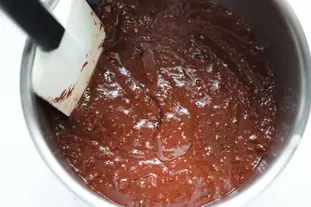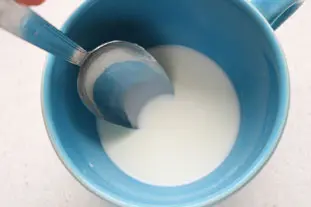This site uses only a few technical cookies necessary for its operation. By continuing to browse, you accept their use.
To find out more...
To find out more...
The dissociation of a preparation

It may have already happened to you: You prepare a sauce, a cream, a ganache etc. and then suddenly or almost, the whole thing dissociates, and from a smooth mixture that you were preparing with love, you end up with a horrible thing with a more or less solid part and another liquid part.
It's the dissociation, or as the french pastry chefs and cooks say, "it's tranché!".
It's the dissociation, or as the french pastry chefs and cooks say, "it's tranché!".
12 K 4.9/5 (13 reviews)
Keywords for this post:CreamSauceProblemDissociationSolidLiquidLast modified on: January 22th 2022
The dissociation of a preparation
For example, here is a chocolate-hazelnut ganache that is tranché:
It doesn't show up very well in the (small) photo, but there's a thick chocolate-hazelnut pan base, and on top a layer of liquid fat.
In the vast majority of cases, it's because in your mixture there is a fatty part and a watery part, the whole thing comes together in a delicate balance.
If this balance is broken because there is too much of one or the other, or a thermal shock, the whole which was homogeneous dissociates, it cuts!
This imbalance is often caused by the heating, perhaps excessive, of the preparation, and during this heating the water can evaporate and reduce, the fat not.
This is what happened with the ganache above, I didn't remove the simmering cream from the heat soon enough before adding the chocolate and hazelnut powder, sad result.
Another example, a bearnaise sauce or a hollandaise sauce that slices when it was almost finished, it's certainly because there was too much butter added and not enough water in the vinegar-wine-herb or lemon reduction.
And besides, it doesn't prevent this tragedy, there is little or no warning of disaster for an amateur, it is quite brutal.
1) Don't panic, don't despair, because it's very easy in this situation, so great is the disappointment, to swear a good big blow, to say to oneself that it's ruined, and to throw everything away...
2) Keep a critical eye: OK it's tranché, but what if it lacks water? Let's try to compensate it, and for that :
- Remove immediately from the heat or the water bath
- Add, very cold, a little bit of water (Béarnaise) or one of the components that brings it (cream for the ganache).
- Take the mixture back slowly, with a whisk, a spatula or a maryse to incorporate this addition (cross your fingers too, put all the chances on your side ;-).
3) If it still doesn't work, use the super power of cornstarch:
- Incorporate a mixture made of a tablespoon of water and a teaspoon of cornstarch in the preparation that you will put back on the fire and will whip until return of the initial texture.
You will have understood, there is no fatality in these small culinary dramas, it is just a bit of physics in your pan, it is necessary to try to be attentive enough during your preparation, to prevent rather than to cure.
To sum up: A preparation that goes off is most of the time an imbalance of water/fat, an imbalance that you can try to reduce or eliminate to regain the initial smoothness.

It doesn't show up very well in the (small) photo, but there's a thick chocolate-hazelnut pan base, and on top a layer of liquid fat.
What happened?
In the vast majority of cases, it's because in your mixture there is a fatty part and a watery part, the whole thing comes together in a delicate balance.
If this balance is broken because there is too much of one or the other, or a thermal shock, the whole which was homogeneous dissociates, it cuts!
This imbalance is often caused by the heating, perhaps excessive, of the preparation, and during this heating the water can evaporate and reduce, the fat not.
This is what happened with the ganache above, I didn't remove the simmering cream from the heat soon enough before adding the chocolate and hazelnut powder, sad result.
Another example, a bearnaise sauce or a hollandaise sauce that slices when it was almost finished, it's certainly because there was too much butter added and not enough water in the vinegar-wine-herb or lemon reduction.
And besides, it doesn't prevent this tragedy, there is little or no warning of disaster for an amateur, it is quite brutal.
What to do if it does?
1) Don't panic, don't despair, because it's very easy in this situation, so great is the disappointment, to swear a good big blow, to say to oneself that it's ruined, and to throw everything away...
2) Keep a critical eye: OK it's tranché, but what if it lacks water? Let's try to compensate it, and for that :
- Remove immediately from the heat or the water bath
- Add, very cold, a little bit of water (Béarnaise) or one of the components that brings it (cream for the ganache).
- Take the mixture back slowly, with a whisk, a spatula or a maryse to incorporate this addition (cross your fingers too, put all the chances on your side ;-).

3) If it still doesn't work, use the super power of cornstarch:
- Incorporate a mixture made of a tablespoon of water and a teaspoon of cornstarch in the preparation that you will put back on the fire and will whip until return of the initial texture.

You will have understood, there is no fatality in these small culinary dramas, it is just a bit of physics in your pan, it is necessary to try to be attentive enough during your preparation, to prevent rather than to cure.
To sum up: A preparation that goes off is most of the time an imbalance of water/fat, an imbalance that you can try to reduce or eliminate to regain the initial smoothness.
Lasts posts
Butter vs. grease
We often read in a recipe where a pastry is put into a mould that, just before pouring, the mould should be buttered or greased. But what's the difference between these 2 terms?December 1st 20256895
Getting out of the fridge early
Very often when you're cooking, you need to take food or preparations out of the fridge, to use them in the recipe in progress. There's nothing tricky about this: you just take them out of the fridge and use them, usually immediately, in the recipe. But is this really a good method?November 24th 20259715
Who's making the croissants?
When you look at a bakery from the outside, you naturally think that in the bakery, the bakers make the bread, and in the laboratory, the pastry chefs make the cakes. It's very often like that, with each of these professions having quite different ways of working, but sometimes there's also one...November 23th 2025872
Oven height
When we put a dish or cake in the oven, we naturally tend to put it on the middle shelf, and that's what we usually do. But in some cases, this position and height can be a little tricky, so let's find out why.October 8th 20252,4775
The importance of sieving
In recipes that use a fine powder (flour, powdered sugar, etc.), you'll often see the advice to sift before using it. To sift is to pass the powder in question through a sieve (a very fine strainer) before incorporating it into your recipe. It's often advice, but is it really useful?September 3rd 20257,3513
Other pages you may also like
Well-cooked meat
Have you ever noticed that if you like your meat well done, it invites strange looks? For instance, in a restaurant, when asked “How would you like that cooked?” If you reply, “Well done,” it is almost as if you are swearing….May 21th 201134 K 14.4
The bitterness of endives
As I write these lines, we are entering the endive season, and if you like it, it's time to enjoy it, if possible with your local producers. Endive is good, but the reproach that is often made of it, and children in particular, is: "It's bitter! And it is (somewhat) true of course, endives...February 9th 201914 K4.9
The right size of zucchini
When you buy zucchini at the market, you're often offered a wide variety of sizes, from very small to very large. But which ones to choose? Here are a few tips.September 9th 20249,8785
What is the difference between bakery and patisserie?
This is a question that you may well have asked yourself and which I will attempt to answer. In France the two trades of "boulangerie" (bakery) and "pâtisserie" (patisserie and confectionery) have always been quite distinct, but where exactly do the boundaries lie? .February 7th 2017134 K 14.1
For well opened (puffed) cakes
It's always nice to have a well puffed up cake after baking, not only will it taste good but it looks great too. Let's see how to get this beautiful shape almost every time.January 23th 201935 K4.2
Post a comment or question
Follow this page
If you are interested in this page, you can "follow" it, by entering your email address here. You will then receive a notification immediately each time the page is modified or a new comment is added. Please note that you will need to confirm this following.
Note: We'll never share your e-mail address with anyone else.
Alternatively: you can subscribe to the mailing list of cooling-ez.com , you will receive a e-mail for each new recipe published on the site.









